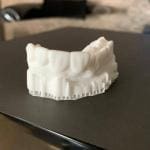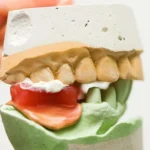Dental impressions are a fundamental aspect of dentistry, enabling precise replication of a patient’s oral structures to fabricate prosthetics, restorations, or orthodontic devices. The accuracy and quality of these impressions are directly related to the dental impression materials used. In this comprehensive guide, we will explore the various types of dental impression materials, their properties, indications, advantages, and disadvantages.
Dental Impression Materials Meaning
Dental impression materials are substances used to create an accurate replica of the patient’s teeth and surrounding oral tissues. These replicas are crucial for the fabrication of custom-fit dental restorations, crowns, bridges, dentures, orthodontic devices, and other prosthetic appliances. The choice of impression material depends on several factors, including the specific clinical scenario, patient preferences, and the dentist’s expertise.
Types of Dental Impression Materials
Dental impression materials can be broadly categorized into five main types based on their composition and setting mechanisms:
- Elastomeric Impressions
- Alginate Impressions
- Plaster Impressions
- Zinc Oxide Eugenol Impressions
- Hydrocolloids
Elastomeric Impressions
These materials are widely used in modern dentistry due to their high accuracy and flexibility. They are typically based on silicone, polyether, and polyvinyl siloxane (PVS) chemistries.
Alginate Impressions
Alginate, derived from seaweed, is a commonly used material for preliminary impressions. It is easy to use, cost-effective, and well-tolerated by patients. However, it lacks the precision required for intricate restorations.
Plaster Impressions
Plaster or gypsum-based materials are used for creating study models or primary impressions. They are inexpensive and provide good detail reproduction.
Zinc Oxide Eugenol Impressions
These materials are used for special cases, such as making impressions for edentulous patients. They offer good flow properties and are suitable for patients with compromised oral health.
Hydrocolloids
Hydrocolloids, either reversible (agar) or irreversible (alginate), are materials that change state with temperature variations. Agar hydrocolloids are used in specific situations due to their superior detail reproduction.
Properties of Dental Impression Materials
- Dimensional Stability
- Flow and Detail Reproduction
- Setting Time
- Tear Strength
- Elastic Recovery
Dimensional Stability
Dental impression materials should maintain their dimensions after setting to provide an accurate replica of the oral tissues.
Flow and Detail Reproduction
Ideal materials should exhibit proper flow to capture fine details and intricate surfaces within the oral cavity.
Setting Time
The setting time of an impression material is crucial, as it impacts the clinician’s working time and the patient’s comfort.
Tear Strength
The material’s tear strength ensures that the impression does not distort or tear during removal from the mouth or when pouring the impression.
Elastic Recovery
This property refers to the ability of the material to return to its original shape after deformation, ensuring an accurate impression.
Indications for Dental Impression Materials
The selection of a specific dental impression material is guided by the clinical scenario and the intended use of the impression. Here are common indications for different types of dental impression materials:
Elastomeric Impressions
Elastomeric materials are ideal for crown and bridge impressions, implant impressions, and other restorative prosthetics due to their high accuracy and stability.
Alginate Impressions
Alginate is commonly used for preliminary impressions, orthodontic models, and diagnostic castings.
Plaster Impressions
Plaster impressions are used for study models, orthodontic treatment planning, and primary impressions in edentulous patients.
Zinc Oxide Eugenol Impressions
These materials are reserved for special cases, such as impressions for denture fabrication in patients with compromised oral health.
Hydrocolloids
Hydrocolloids, both reversible and irreversible, are used for edentulous impressions and occasionally for orthodontic models.
Advantages and Disadvantages of Dental Impression Materials
Elastomeric Impressions
Advantages:
- Excellent accuracy and detail reproduction.
- High tear strength and elasticity.
- Long shelf life.
Disadvantages:
- Relatively expensive.
- Sensitive to moisture.
Alginate Impressions
Advantages:
- Cost-effective.
- Easy to use.
- Well-tolerated by patients.
Disadvantages:
- Limited accuracy and dimensional stability.
- Short setting time.
Plaster Impressions
Advantages:
- Inexpensive.
- Good detail reproduction for study models.
Disadvantages:
- Fragile and susceptible to damage.
- Limited applications due to lack of accuracy.
Zinc Oxide Eugenol Impressions
Advantages:
- Good flow properties.
- Suitable for compromised oral health.
Disadvantages:
- Dimensional instability.
- Unpleasant taste and odor.
Hydrocolloids
Advantages:
- Good flow and detail reproduction.
- Less expensive than elastomeric materials.
Disadvantages:
- Sensitive to temperature changes.
- Limited shelf life.
Recent Advances in Dental Impression Materials
In recent years, there have been significant advancements in dental impression materials aimed at improving accuracy, patient comfort, and ease of use. Here are some of the notable advancements:
Digital Impression Systems
The advent of digital impression systems has revolutionized the field of dentistry. These systems use intraoral scanners to create highly accurate 3D digital models of the patient’s teeth and oral tissues. Digital impressions offer several advantages over traditional impression materials:
Precision and Accuracy
Digital impressions provide highly precise digital models, minimizing the risk of errors associated with traditional materials.
Patient Comfort
Patients generally find digital impressions more comfortable compared to traditional impressions, as they avoid the need for trays and impression materials in the mouth.
Efficiency
Digital impressions are faster and more efficient, reducing chair time and enabling quicker turnaround for restorations.
Polyvinyl Siloxane (PVS) Improvements
Polyvinyl siloxane (PVS) remains one of the most widely used elastomeric impression materials. Recent improvements in PVS technology have focused on enhancing its properties:
Hydrophilic Formulations
Newer hydrophilic PVS formulations have improved wetting characteristics, ensuring better contact with the tooth surface and improved detail reproduction.
Increased Tear Strength
Modern PVS materials exhibit higher tear strength, reducing the risk of distortion during impression removal.
Low Viscosity Options
Low viscosity PVS materials enable better flow into subgingival areas, enhancing accuracy in crown and bridge impressions.
Hybrid Impression Materials
Hybrid impression materials combine the advantages of multiple material types, offering improved properties and versatility. These materials may incorporate elements of elastomers and hydrocolloids, providing enhanced detail reproduction and dimensional stability.
Improved Dimensional Stability
Hybrid materials often exhibit superior dimensional stability compared to traditional hydrocolloids.
Enhanced Flow Characteristics
Incorporating elastomeric properties into hydrocolloid-based hybrids improves flow characteristics, enabling better detail reproduction.
Antimicrobial Impression Materials
In response to the growing concern of infection control in dental practice, some impression materials now contain antimicrobial agents. These agents help prevent microbial growth on the impression surface, maintaining hygiene throughout the process.
Reduced Contamination Risks
Antimicrobial agents inhibit bacterial growth, reducing the risk of cross-contamination during handling and storage of impressions.
Extended Shelf Life
Antimicrobial properties contribute to a longer shelf life of the impression material.
Future Trends and Prospects
The field of dental impression materials continues to evolve, driven by advancements in materials science and a focus on patient-centric approaches. Several trends are shaping the future of dental impressions:
Nanotechnology Integration
Incorporating nanomaterials into impression materials holds promise for improving properties such as strength, flexibility, and antimicrobial features.
Biocompatible Materials
Future materials will emphasize biocompatibility, ensuring minimal allergic reactions and improved patient safety.
Real-Time Feedback and Monitoring
Integration of sensors within impression materials for real-time feedback during the impression process, allowing for adjustments and improvements on the spot.
3D Printing of Impression Trays
Utilizing 3D printing to create customized impression trays based on patient anatomy for a more comfortable and accurate impression process.
Conclusion
Dental impression materials play a vital role in modern dentistry, facilitating the creation of precise replicas of a patient’s oral structures for various clinical and laboratory purposes. Dentists must carefully select the appropriate impression material based on the specific clinical requirements and patient needs to ensure optimal results in the fabrication of dental restorations and prosthetics. Understanding the properties, indications, advantages, and disadvantages of different types of dental impression materials is crucial for providing high-quality dental care and achieving successful treatment outcomes.





